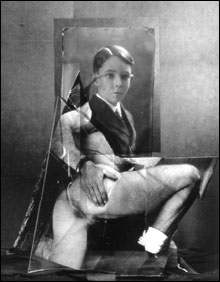 More goes on in a single John O’Reilly photo collage than in the entirety of most museum and gallery exhibits — group shows and retrospectives included — so the 22 works on view at the Howard Yezerski Gallery feel like a concentrated trip to the Louvre. He’s inexhaustible; there’s no way to take everything in.
More goes on in a single John O’Reilly photo collage than in the entirety of most museum and gallery exhibits — group shows and retrospectives included — so the 22 works on view at the Howard Yezerski Gallery feel like a concentrated trip to the Louvre. He’s inexhaustible; there’s no way to take everything in.
Which doesn’t mean O’Reilly is all over the place. In fact, he’s a refined if matter-of-factly outrageous stylist. To see him once is to recognize him forever. Working strictly in black and white, the artist orchestrates fragments of photographic images — some he takes himself, others come out of places like art-history books, porn magazines, and flea-market photo albums. Then he fragments further, scissoring into reproductions of masterpieces, dismembering bodies, creating silhouettes, and adding snapshots of views from his suburban home. What emerges are lyrical, spatially bizarre, frequently hilarious, charged assemblages. He’s a uniquely American surrealist whose indirection and complexity serve dramatic, emotional, and political ends.
O’Reilly’s peculiar celebration and investigation of the male body succeeds at making the erotic register as innocent and innocence register as sexually charged. In Bottom we see what appears to be a fraction from a 1950s porn magazine — the back side of a muscular body spreads the cheeks of his ass with his right hand as one lifted leg bends on a tabletop. The invitation to penetrate is unmistakable. Yet superimposed on the head is a studio portrait, circa 1930, of a smooth-faced, handsome schoolboy — wide-eyed, expectant, hair neatly parted, comfortable in his jacket and tie. The effect of the piece goes far beyond its jarring juxtaposition of naiveté and sexual solicitation. It’s as though the artist were saying that the natural or inevitable outcome of middle-class convention is desire run amuck. The boy doesn’t exist below the waist; the man doesn’t exist above the shoulder, and though the two can’t be described as seamlessly joined, the scale and contours of the child’s upper body fit precisely onto his grafted adult form. The result is unnervingly credible, an all-human satyr, but instead of the mythic beast’s horniness belonging to his equine lower parts, in O’Reilly’s mythology it belongs to the passage of time. Given the implied eras of the man and boy, they could conceivably be the same person.
O’Reilly continually plays with the interchangeability of the pure and the vulgar, the appetites of the flesh and the longings of the spirit. The immediately identifiable image in Dancer is the left side of a naked, athletic, 19th-century-looking man poised with his legs spread wide and a hand boldly resting on his hip. It’s not just his body but his face as well that appears determined to defy gravity. Surrounding the dancer are other men’s even more fractured body parts, hands and arms mostly, clothed and unclothed, gigantic and miniature. Given the multiple planes and multiple personae, it’s a while before you notice that the partial hand that substitutes for the dancer’s missing torso bleeds from a hole at its center — the stigma of the crucified Christ. The hand of God forms the dancer’s corpus, its wound corresponds with the dancer’s chest. Redemption and athleticism, defiance and death, self-consciousness and eternity’s abyss become one.
In one of the exhibit’s most riveting and tender works, Men, a hand is grafted to the right side of a naked male torso, but here the body belongs to Christ on the crucifix and the oversized forefinger and thumb — belonging to a different man — are in the act of stroking his as yet unexcited penis. Self-sacrifice becomes self-gratification; pain melds into pleasure; the limp body that has promised to rise connects with the limp body part that promises the same. Both heads slump forward, one between outstretched arms, the other between outstretched digits.
ADVERTISEMENT
 |
The same iconoclastic impishness O’Reilly brings to his treatment of personal and religious themes becomes ribald when he takes on the ostensible division between high art and low. In Artist Model, a ridiculously reclining male nude (he’s way too buff to be voluptuous) springs an erection as he stares into a mirror held up by a Cupid, except the mirror isn’t traditionally reflective. Instead of returning its gazer’s form, we see the hand of an artist in the act of painting his picture. What could be more exciting? In Two Artists, a reproduction of Velasquez’s Queen Mariana depicts the elaborately dressed young noblewoman gesturing as if to curtsy. Superimposed on her magnificent skirt is an early art photo of the backsides of two naked boys lingering in a field of grass. In As Verlaine and Rimbaud, O’Reilly affixes pictures of the poets’ heads onto two separate photos of his own hairless, pale torso, which he’s mounted in an old-fashioned, two-panel, free-standing frame as if to keep on his dresser bureau.